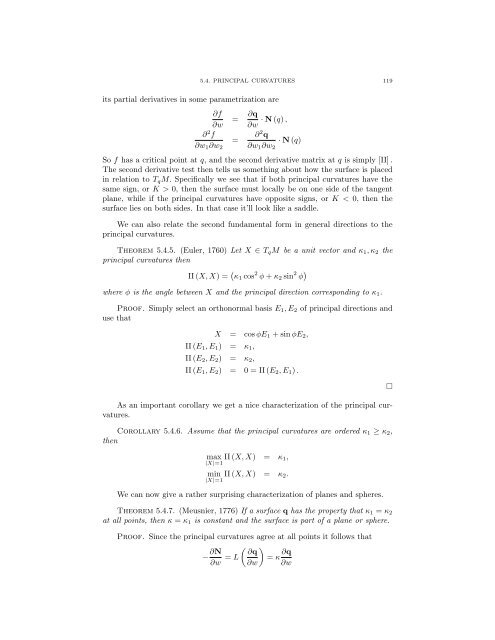Lecture Notes for 120 - UCLA Department of Mathematics
Lecture Notes for 120 - UCLA Department of Mathematics
Lecture Notes for 120 - UCLA Department of Mathematics
You also want an ePaper? Increase the reach of your titles
YUMPU automatically turns print PDFs into web optimized ePapers that Google loves.
5.4. PRINCIPAL CURVATURES 119<br />
its partial derivatives in some parametrization are<br />
@f<br />
@w = @q<br />
@w · N (q) ,<br />
@ 2 f<br />
@w 1 @w 2<br />
=<br />
@ 2 q<br />
@w 1 @w 2<br />
· N (q)<br />
So f has a critical point at q, andthesecondderivativematrixatq is simply [II] .<br />
The second derivative test then tells us something about how the surface is placed<br />
in relation to T q M. Specifically we see that if both principal curvatures have the<br />
same sign, or K>0, then the surface must locally be on one side <strong>of</strong> the tangent<br />
plane, while if the principal curvatures have opposite signs, or K < 0, then the<br />
surface lies on both sides. In that case it’ll look like a saddle.<br />
We can also relate the second fundamental <strong>for</strong>m in general directions to the<br />
principal curvatures.<br />
Theorem 5.4.5. (Euler, 1760) Let X 2 T q M be a unit vector and apple 1 ,apple 2 the<br />
principal curvatures then<br />
II (X, X) = apple 1 cos 2 + apple 2 sin 2<br />
where is the angle between X and the principal direction corresponding to apple 1 .<br />
Pro<strong>of</strong>. Simply select an orthonormal basis E 1 ,E 2 <strong>of</strong> principal directions and<br />
use that<br />
X = cos E 1 +sin E 2 ,<br />
II (E 1 ,E 1 ) = apple 1 ,<br />
II (E 2 ,E 2 ) = apple 2 ,<br />
II (E 1 ,E 2 ) = 0 = II(E 2 ,E 1 ) .<br />
As an important corollary we get a nice characterization <strong>of</strong> the principal curvatures.<br />
Corollary 5.4.6. Assume that the principal curvatures are ordered apple 1 apple 2 ,<br />
then<br />
max II (X, X) = apple 1,<br />
|X|=1<br />
min II (X, X) = apple 2.<br />
|X|=1<br />
We can now give a rather surprising characterization <strong>of</strong> planes and spheres.<br />
Theorem 5.4.7. (Meusnier, 1776) If a surface q has the property that apple 1 = apple 2<br />
at all points, then apple = apple 1 is constant and the surface is part <strong>of</strong> a plane or sphere.<br />
Pro<strong>of</strong>. Since the principal curvatures agree at all points it follows that<br />
✓ ◆<br />
@N @q<br />
@w = L = apple @q<br />
@w @w<br />
⇤
















